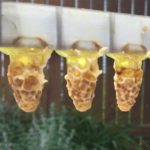“Spellbinding” is just one of the words I heard describing the nearly two hour presentation by Dr. Meghan Milbrath at the July Kalamazoo Bee Club meeting. With her frank, witty and friendly delivery, Meghan’s advice–backed by experience and research—offered something to all levels of beekeepers. “If I’d heard this talk my first year, I would’ve killed fewer bees,” a third-year beekeeper shared with me afterward.
Just a few of the dozens of key points Meghan offered:
When you can’t find the queen, you probably don’t need to buy another. Meghan went over the rationale and timeline for when a colony goes queenless, highlighting that understanding basic bee biology and patience are key. “The problem is typically not in the colony, but in the beekeeper’s expectations,” she noted.
There are only two reasons why you would ever need to purchase another queen: to add new genetics to your yard, and to expand your operation. As queen events “routinely” happen (swarms, squishes, supercedures), Meghan strongly recommends having a nuc hive in every yard. It gives you a spare queen at the ready, as well as resources you can share throughout the yard – like by using a frame of brood from that nuc on a struggling production colony.
There are two major swarming periods – the spring reproductive swarming period, and then summer swarming that occurs when the queen has no place to lay. In spring, on the strong, overwintered colonies, “you probably can’t oversuper.” And as for the summer swarm pressure: make sure the brood area has plenty of drawn comb for her majesty to lay in, especially during nectar flows.
The world, and especially Michigan among other states, still has a “very bad” epidemic status regarding mites. A responsible beekeeper MUST be monitoring and controlling mites, for the health of their colonies as well as the colonies around them (both feral and belonging to other beekeepers.) You are your neighbor’s beekeeper.
A colony with mite levels over threshold in August is “dead hive walking”, although it may go through more suffering until that’s comes to fruition. Having a healthy colony in August is essential because those are the bees making the bees that need to get through winter. Monitor (alcohol wash or powdered sugar roll) and keep the mites (that ALL colonies have) under control.
A push-in queen cage is Meghan’s preferred method for queen introduction; there are a number of ways to increase queen acceptance; don’t work a hive when its shadow is taller than the hive (“or,” said Meghan, “when you’re crying and bloodied” – although she’s done that also.) Meghan’s working on publishing a number of articles, how-to’s and trouble-shooting aids to cover these and other topics – I’m working with her to develop them and get them distributed, because as another audience member told me, “absolutely every beekeeper should hear what she has to say.”
